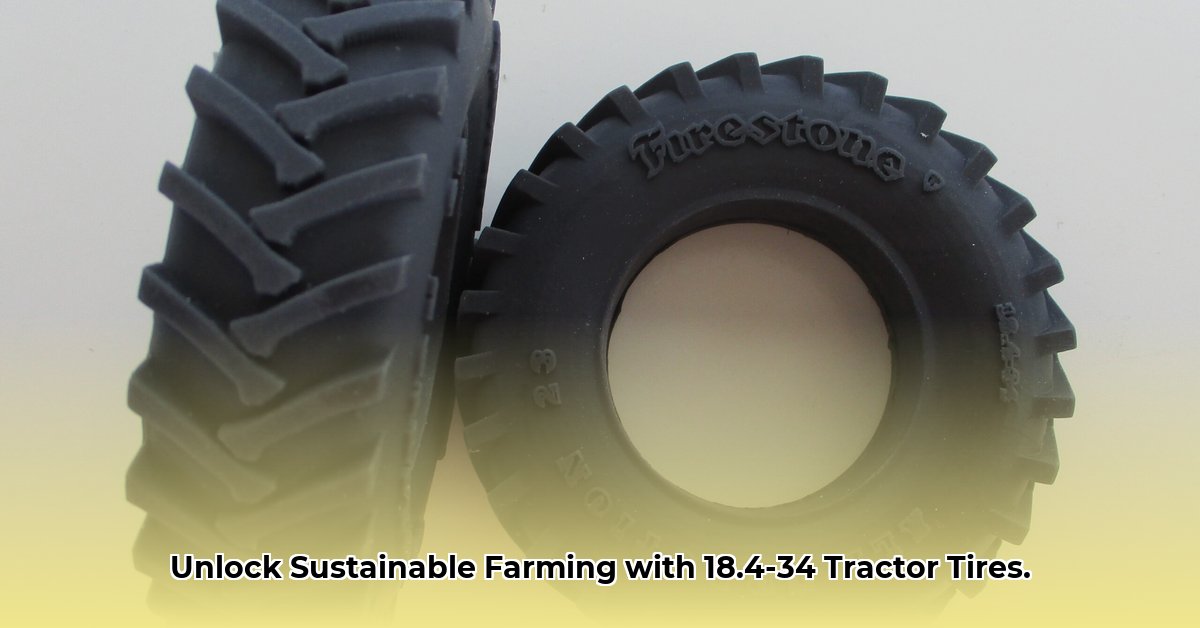
Choosing the right tractor tires is a critical decision impacting farm efficiency, soil health, and environmental sustainability. The 18.4-34 is a popular size, but its suitability depends on various factors. This guide provides actionable advice for maximizing its benefits and minimizing its drawbacks within a sustainable farming context. For more information on inner tubes, check out this resource: inner tube options.
Is an 18.4-34 Tractor Tire Right for Your Farm?
The 18.4-34 tire offers robust construction and good traction, making it a workhorse in many farming operations. However, its suitability depends on several key factors:
Soil Type: Heavy clay soils benefit from the 18.4-34's wide footprint, which reduces soil compaction. However, on lighter, sandier soils, this larger tire might cause unnecessary disturbance. Lighter soils may be better suited to smaller tires.
Climate: In wet conditions, the 18.4-34's superior traction is advantageous, preventing bogging and soil damage. In dryer climates, however, its larger surface area can increase fuel consumption. A smaller tire might be more fuel-efficient in such conditions.
Crop Type: Row crops necessitate careful consideration of tire width to avoid damaging plants. The 18.4-34 might be unsuitable for narrow row spacings but well-suited for wider ones.
Tractor Model: Always consult your tractor's manual for recommended tire sizes to ensure compatibility and optimal performance. Fitting the wrong tire can lead to safety hazards and reduced efficiency.
Determining the optimal tire requires careful evaluation of these factors to ensure both efficiency and sustainability.
Mastering Tire Inflation: Fuel Efficiency and Soil Health
Proper tire inflation is crucial for both fuel efficiency and soil health. Underinflation increases rolling resistance, leading to higher fuel consumption and increased soil compaction. Overinflation, conversely, can cause uneven tire wear, reduce traction, and even lead to tire failure.
A Step-by-Step Guide to Optimal Inflation:
Consult your tractor's manual: This provides the recommended pressure range for your 18.4-34 tires under various conditions.
Assess soil conditions: Dry, hard soils generally require higher pressures, while wet, soft soils require lower pressures to maximize traction and minimize compaction. Monitor soil conditions and adjust accordingly. Isn't consistent monitoring of your soil conditions incredibly important for optimal tire pressure?
Regularly monitor: Using a quality pressure gauge, check tire pressure frequently – ideally before each use – to ensure it remains within the recommended range. Regular checks are critical for maintaining performance.
Adjust accordingly: As soil conditions and workloads change, adjust your tire pressure as needed to maintain efficiency and prevent damage.
Finding the ideal tire pressure is an iterative process requiring observation and adjustment based on your farm's unique conditions. This fine-tuning can significantly impact profitability.
Tire Maintenance: Protecting Your Investment and Reducing Environmental Impact
Regular maintenance is essential for extending the lifespan of your tires and reducing waste. Neglecting maintenance accelerates tire wear, leading to higher costs and potential environmental implications. Don't underestimate the importance of this often-overlooked aspect of sustainable farming!
Regular Inspections: Conduct a visual inspection before each use, checking for cuts, embedded objects, and uneven wear. Early detection prevents small problems from becoming major issues. How often do you conduct these checks? Daily? Weekly?
Thorough Cleaning: Remove mud and debris after each use to prevent overheating and accelerated wear. This also makes any damage easier to spot.
Proper Storage: When not in use, store tires in a cool, dry place, protected from sunlight and extreme temperatures to prevent cracking and degradation of the rubber. Proper storage can significantly extend the useful life of your tires.
By consistently performing these simple maintenance tasks, you can significantly extend the life of your tires, realizing cost savings and reducing the environmental impact associated with premature replacement.
The Environmental Footprint: Sustainable Practices Across the Tire's Life Cycle
The environmental impact of tractor tires extends beyond fuel efficiency. Consider the tire's entire life cycle:
Manufacturing: Tire production consumes energy and resources. Supporting manufacturers committed to sustainable practices reduces the environmental burden. Are you aware of the manufacturers' sustainability initiatives?
Materials: The use of recycled materials in tire manufacturing is growing. Choosing tires made with recycled materials or sustainable rubber directly reduces environmental harm.
Disposal: Proper disposal is crucial at the end of a tire’s life. Recycling programs offer an environmentally responsible way to manage worn-out tires and prevent landfill accumulation. What are the recycling options available in your area?
Case Study: Farm X and the Benefits of Sustainable Tire Management
Farm X, a diversified farm in Iowa, switched to 18.4-34 tires designed for compaction reduction. They reported a 10% reduction in fuel consumption and a 5% increase in crop yields. This demonstrates that strategic tire selection and management significantly impact profitability and environmental sustainability. This shows how sustainable practices boost the bottom line.
Conclusion: Choosing the Right Tire for Sustainable Success
The 18.4-34 tractor tire is a versatile option, but its suitability depends on individual farm conditions. Careful consideration of soil type, climate, crop type, and tractor compatibility is crucial for sustainable, efficient farming. Proper inflation, regular maintenance, and responsible tire disposal contribute significantly to a more sustainable and profitable farming operation.